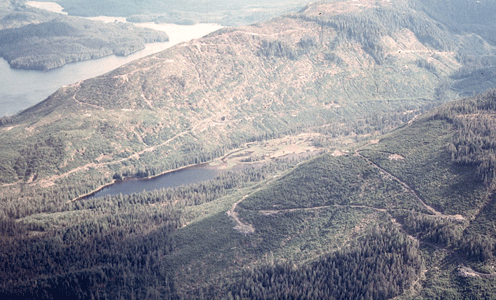 |
“Forests have a vital role to play in overcoming this challenge. Rainforests store vast amounts of carbon. That’s true across the planet, and in America, too. Our Tongass National Forest,
a temperate Alaskan rainforest, comprises only 2% of America’s forest land base, but may hold as much as 8% of all the carbon contained in the forests of the United States.” -- Secretary of Agriculture, Tom Vilsack, 17 Dec. 2009
a temperate Alaskan rainforest, comprises only 2% of America’s forest land base, but may hold as much as 8% of all the carbon contained in the forests of the United States.” -- Secretary of Agriculture, Tom Vilsack, 17 Dec. 2009
Forests and Carbon Cycles
Forests are a critical part of the global atmospheric carbon cycle that contribute to climate stabilization by absorbing (sequestering) and storing vast amounts of carbon dioxide (CO2) in trees (live and dead), soils, and understory foliage.
 |
As a forest ages, it continues to accumulate and store carbon, functioning as a net carbon “sink” for centuries. Ongoing carbon accumulation and storage have been measured in forests that are >800 years old1.
When an old-growth forest is cut down, much of this stored carbon is released as CO2 – a global-warming pollutant. In fact, nearly 60% of the carbon stored in an old-growth forest is emitted as CO2 when it is converted to a tree plantation, via decomposition of logging slash, fossil-fuel emissions from transport and processing, and decay or combustion (within 40-50 years) of forest products, often in landfills2. Planting or growing young trees does not make up for this release of CO2 from a logged forest. Indeed, after a forest is clearcut, it remains a net CO2 emitter for its first 15 or more years, and even if not cut down again will not reach the levels of carbon stored in an old forest for centuries. Globally, forestry-related losses contribute about 17% of the world’s annual greenhouse gas pollutants3, more than the entire global transportation network, which is why many countries are seeking ways to reduce greenhouse gas emissions from logging.
 |
|
Logging in the Tongass rainforest releases vast amounts of CO2 as a global warming pollutant |
Enlisting Carbon Rich Forests in Climate Change Actions
Scientists and many countries have increasingly recognized that if we are to avoid catastrophic effects of global warming within this century, we must take a comprehensive approach to reducing greenhouse gas pollution overall. Part of the solution to global warming must come from reducing emissions from forest losses, as recognized by the United Nations REDD+ Programme in developing countries4.
Forests in the United States, especially older carbon dense ones, can play a critical role in reducing climate change impacts through sequestering and storing carbon for centuries if undisturbed. New forest inventories demonstrate that the U.S. forests store the equivalent of around 21% of the nation’s emissions5. Notably, National Forests store approximately 28% more carbon than private lands and therefore are important as carbon sinks.
Importantly, forests in the Pacific Northwest are nationally significant carbon stores6, mostly because of the strategic role older forests provide as carbon sinks. Notably, mature moist forests on public lands in Oregon and Washington store the equivalent of nearly 130 times the state’s annual greenhouse gases7. Alaska’s Tongass rainforest is also a global champion in storing carbon, storing the equivalent of nearly 80 times Alaska’s annual emissions8.
In June, President Obama announced his Climate Action Plan. Among the President’s many steps to reduce greenhouse gas emissions by 2020, he specifically calls out forests – “the Administration is working to identify new approaches to protect and restore our forests, as well as other critical landscapes including grasslands and wetlands, in the face of a changing climate.”
Since forests play a such a critical role in the global atmospheric carbon cycle by absorbing and storing vast amounts of carbon, protecting forests, especially old growth forests like those in the Pacific Northwest and the Tongass Rainforest in Alaska, should be a key component of any plan to mitigate the effects of climate change.
1 Luyssaert, S. et al. 2008. Old-growth forests as global carbon sinks. Nature 455:213-215
2 Harmon, M.E. W.K Ferrel, J. F. Franklin. 1990. Effects on carbon storage of conversion of old –growth forests to young forests. Science 247:699-702
3 Intergovernmental Panel on Climate Change. 2007. Synthesis report. An assessment of the IPCC on climate change.
4 http://www.un-redd.org/
5 King et al. 2012: Front. Ecol. Enviro 10 (10):512-519.
6 www.fs.fed.us/rmrs/forest-carbon/
7 Over 9 million acres of older carbon dense forests have been identified in Oregon and Washington (Krankina in review). These 9 million acres store about 450 metric tons of carbon per acre or 15 billion metric tones of CO2 (e) total. By 8 comparison, Oregon and Washington emitted about 115 million metric tones of CO2 (e) in 2010.
5 million acres of old-growth rainforest store about 234 metric tons of carbon per acre or 4 billion metric tons of CO2 (e). By comparison, Alaska emitted 55.2 million metric tons of CO2 (e) in 2010.
